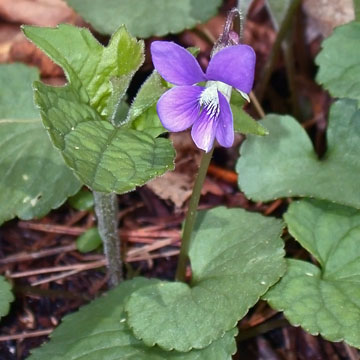

Viola palmata - (image 1 of 4)
Taxonomy
Family: Violaceae
Habitat
Dry forests, woods, rocky and talus slopes and fields. The southern var. heterophylla prefers wetter habitats.
Associates
Distribution
Central and eastern North America. Typical V. palmata usually has pubescent leaf surfaces and is widespread in dry habitats. The var. heterophylla is usually glabrous and is restricted to the coast from VA south to TX.
Morphology
Acaulescent perennial from a thick, fleshy rhizome, stolons not produced. Plants heterophyllous, early and late season leaves unlobed, mid-season leaves with 3-5(-7) lobes, the middle segment larger than the lateral segments and usually unlobed; sepals lanceolate, auricles 0.5-1 mm; petals violet, lower three white basally, lower three and upper two sometimes violet-veined; lateral petals bearded, lowest petal 1.5-2.5 cm and sometimes bearded, spur white, 2-3 mm; capsule ellipsoid, 0.5-1.5 cm, glabrous; seeds beige, mottled to bronze, 1.5-2.5 mm.
Notes
Flowers late April to May
Wetland indicator: FACU
Plants photographed in limestone woods near Albany, NY.
A rare form with deeply cleft blades (forma dilatata) might be confused with V. subsinuata. Unlike V. subsinuata it has 3-7 principal segments, unlobed middle lobes, and often petiolules on the outer pairs of segments.
References
Haines, A. 2002.
Taxonomy of Viola subsinuata in New England. Botanical notes 8:1-4.
Haines, A. 2011.
Flora Novae Angliae: a manual for the identification of native and naturalized
higher vascular plants of New England. Yale University Press, New Haven, CT.
Little, R.J. and
L.E. McKinney. 2015. Viola. In: Flora of North America North of
Mexico, Vol. 6. Oxford University Press, New York and Oxford.
USDA, NRCS. 2002. The PLANTS Database, Version 3.5 (http://plants.usda.gov).
National Plant Data Center, Baton Rouge, LA 70874-4490 USA.
|
Michael Hough © 2017 |